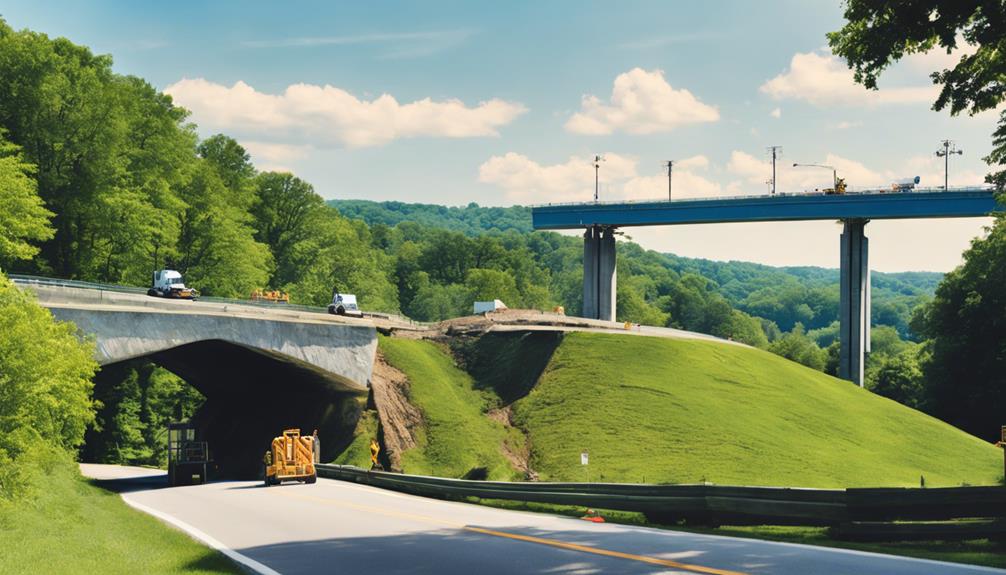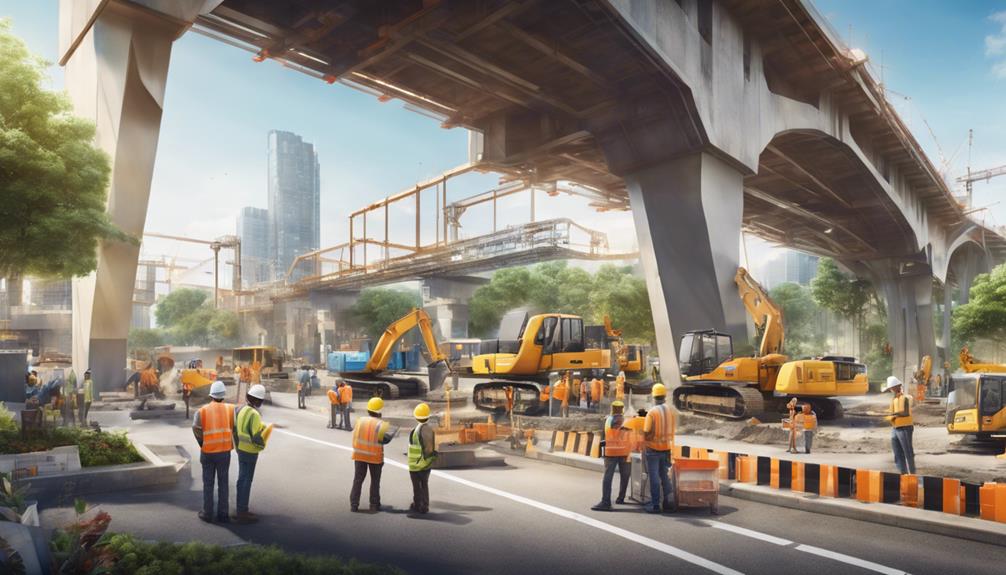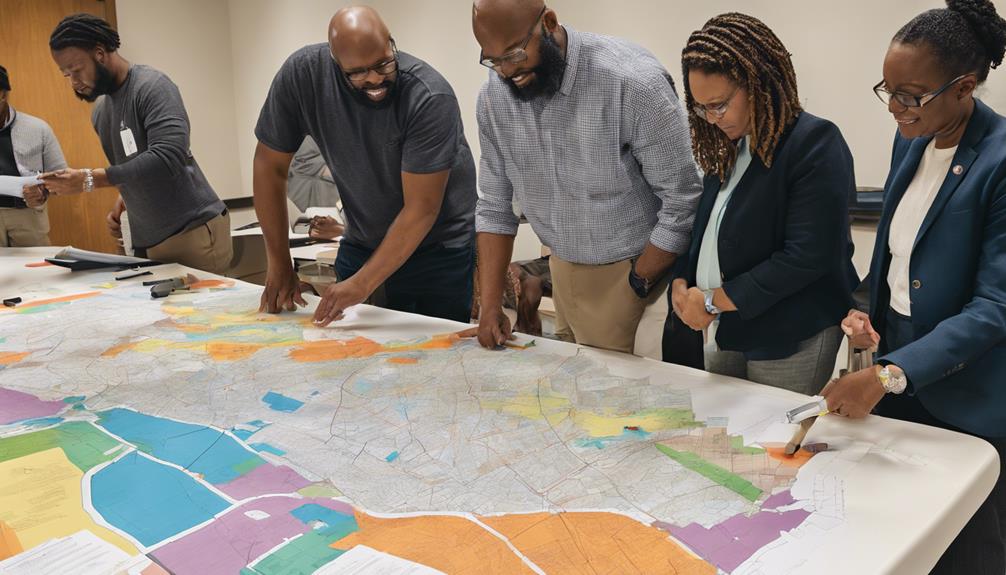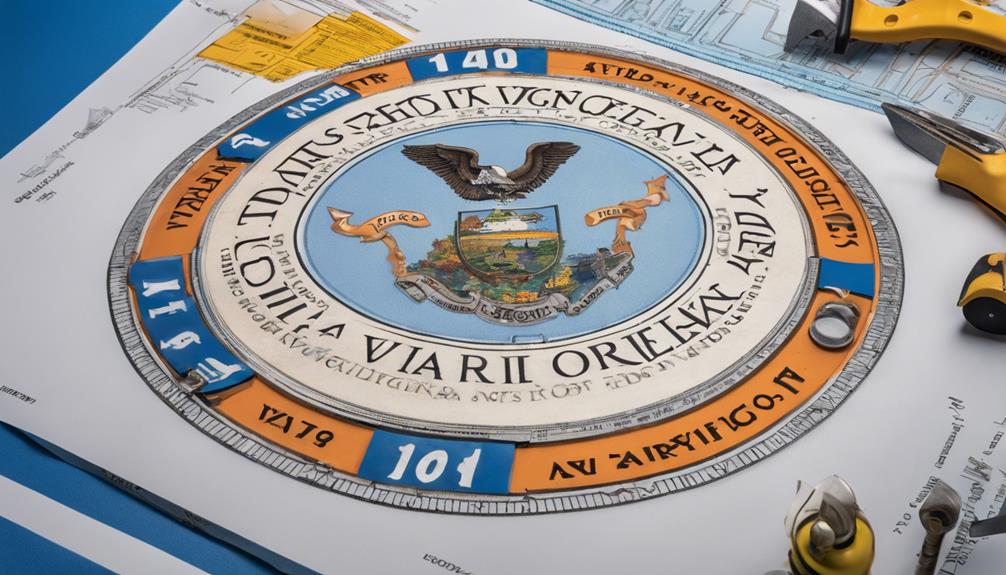When you consider the Virginia VDOT Bond, it's essential to understand how it serves as a backbone for the state's transportation infrastructure. This financial tool not only provides immediate capital for necessary projects but also relies on dedicated revenue streams like fuel taxes. While it promises benefits like job creation and enhanced connectivity, there are underlying challenges and risks that can impact its effectiveness. What are these challenges, and how do they shape the future of infrastructure funding in Virginia?
Overview of VDOT Bond

When you think about funding transportation projects in Virginia, the VDOT Bond often comes to mind as a crucial financial tool. This bond serves as a significant resource for the Virginia Department of Transportation (VDOT), allowing it to secure necessary funding for various infrastructure initiatives.
It's designed to support the development and maintenance of highways, bridges, and public transit systems across the state, ensuring that the transportation network remains robust and efficient.
By issuing VDOT Bonds, the state can access immediate capital, which is vital for addressing urgent transportation needs. This funding mechanism not only helps in tackling existing projects but also facilitates future improvements, fostering economic growth in the region.
You might be aware that these bonds are backed by the state's commitment to repay the borrowed funds, often through dedicated revenue streams, such as fuel taxes or tolls.
In essence, VDOT Bonds play a pivotal role in shaping Virginia's transportation landscape. They enable the state to invest in infrastructure that enhances connectivity and mobility, ensuring that residents and businesses can thrive.
Understanding the VDOT Bond's significance can help you appreciate its impact on transportation development in Virginia.
Purpose of VDOT Bonds
VDOT Bonds serve a vital purpose in financing Virginia's transportation infrastructure projects, enabling the state to address both immediate and long-term needs. By issuing these bonds, Virginia can secure necessary funds to improve roads, bridges, and public transit systems, which directly impacts your daily commute and overall quality of life.
When you consider the increasing population and its demands on transportation networks, VDOT Bonds become essential. They allow for the timely execution of projects that enhance safety and reduce congestion, ensuring you can travel more efficiently.
Moreover, these bonds help maintain existing infrastructure, preventing costly repairs down the line.
Investing in VDOT Bonds also stimulates the local economy. As construction projects get underway, jobs are created, and local businesses thrive with increased activity.
This investment in transportation not only benefits you as a traveler but strengthens the community as a whole.
Types of VDOT Bonds

Virginia employs several types of bonds to fund its transportation initiatives, each designed to meet specific financial needs and project goals.
One common type you'll encounter is general obligation bonds. These are backed by the full faith and credit of the state, meaning they're supported by tax revenues. They're typically used for larger, long-term projects.
Another type is revenue bonds, which you might see for specific projects that generate income, like toll roads or bridges. These bonds are repaid from the revenue generated by those projects, making them a more targeted financing option.
You may also come across grant anticipation revenue vehicles (GARVEEs). These bonds allow the state to borrow against future federal transportation grants, giving you a way to jumpstart projects that might otherwise face funding delays.
Lastly, there are private activity bonds, often used to encourage public-private partnerships. These bonds aim to attract private investment in transportation infrastructure, and they can provide a flexible funding source for innovative projects.
Each bond type plays a vital role in ensuring Virginia's transportation system remains efficient and effective.
Funding Mechanism Explained
How does the funding mechanism for Virginia's transportation initiatives work? The Virginia Department of Transportation (VDOT) uses a combination of state and federal funds, along with bonds, to finance various projects.
When VDOT issues bonds, it borrows money from investors, promising to pay them back with interest over time. This approach allows you to fund large-scale projects upfront instead of waiting for the gradual accumulation of tax revenues.
The bonds are typically backed by revenue sources, like gas taxes or vehicle registration fees, ensuring that there's a steady income stream to repay the investors. This mechanism not only accelerates project timelines but also gives you the ability to tackle critical infrastructure needs more effectively.
Additionally, when the bonds are sold, VDOT can leverage the capital to address immediate transportation challenges, from road repairs to new construction. It's a strategic way to manage cash flow while maintaining essential services.
Benefits for Infrastructure Projects

Infrastructure projects benefit significantly from the strategic use of bonds, allowing for quicker funding and implementation. When you utilize bonds, you unlock immediate capital, streamlining the process of getting projects off the ground. This timely access to funds means you can address urgent needs, like road repairs or bridge upgrades, without delay.
Additionally, obtaining performance bonds ensures that contractors fulfill their obligations, further enhancing project reliability.
Moreover, bonds can spread the financial burden over time. Instead of paying the entire project cost upfront, you can manage payments through scheduled bond repayments. This flexibility helps you allocate resources more efficiently, ensuring that other crucial projects remain funded.
Bonds also enhance project credibility. Investors and stakeholders are more likely to support initiatives backed by solid financial planning. When you issue bonds, it signals to the community that you're committed to improving infrastructure, fostering public trust and engagement.
Lastly, using bonds can lead to cost savings. With favorable interest rates, you might secure lower borrowing costs compared to traditional financing methods. This financial advantage means more resources can go into the actual construction and maintenance of infrastructure, maximizing the impact of every dollar spent.
Embracing bonds can truly elevate your infrastructure initiatives.
Impact on Virginia's Economy
Investing in bonds for infrastructure projects not only enhances project execution but also has a profound impact on Virginia's economy. When you fund these projects, you're directly contributing to job creation. The construction and maintenance of roads, bridges, and public transport systems require a skilled workforce, leading to immediate employment opportunities. This influx of jobs boosts local economies, as workers spend their earnings on goods and services.
Moreover, improved infrastructure increases the efficiency of transportation, reducing costs for businesses and consumers alike. When roads are well-maintained and traffic flows smoothly, businesses can transport goods faster and at lower costs, enhancing their competitiveness. You'll notice that this attracts new businesses to the area, further stimulating economic growth.
In addition, enhanced infrastructure can lead to increased property values. People are more likely to invest in areas with reliable transportation and public services, which can elevate the overall economic landscape of Virginia.
Ultimately, by investing in VDOT bonds, you're not just enhancing infrastructure; you're playing a crucial role in fostering a vibrant and prosperous Virginia economy for everyone.
Challenges and Risks

While the benefits of VDOT bonds are significant, several challenges and risks must be considered. One major concern is the potential for project delays. If a project takes longer than expected, costs can escalate, and budget overruns may occur, putting pressure on state resources.
You also need to be aware of the market conditions. Fluctuations in interest rates can impact the cost of borrowing, making it more expensive to finance projects when rates rise.
Another risk involves public opposition. If community members disagree with a project funded by VDOT bonds, it could lead to delays or even cancellations.
You should also consider the environmental impact. Projects might face scrutiny and regulatory hurdles if they threaten ecosystems or communities.
Future of VDOT Bonding
As Virginia looks ahead, the future of VDOT bonding is poised to evolve in response to changing economic landscapes and community needs.
You'll likely witness increased emphasis on sustainable infrastructure projects, driven by the demand for eco-friendly solutions. This shift not only addresses immediate transportation challenges but also considers long-term environmental impacts.
Moreover, technology will play a crucial role in shaping VDOT's bonding strategies. You might see enhanced data analytics and project management tools that improve transparency and efficiency, ensuring that funds are allocated effectively.
This could lead to more agile and responsive bonding processes that adapt to new priorities as they emerge.
In addition, community engagement is set to become a cornerstone of future bonding initiatives. You'll have opportunities to contribute your voice to project prioritization, ensuring that local needs are met.
This collaborative approach will likely foster greater trust between VDOT and the communities it serves.
As these changes unfold, it's essential to stay informed about new policies and funding opportunities. Your awareness can empower you to better understand how VDOT bonding will influence the future of transportation in Virginia.
How to Get Involved

Getting involved in VDOT bonding initiatives is easier than you might think. First, familiarize yourself with the current projects and proposals on the Virginia Department of Transportation's website. Understanding the scope of these initiatives will help you identify where your interests align.
Next, consider attending public meetings or community forums. These gatherings often provide insight into ongoing projects and allow you to voice your thoughts. Engaging with local leaders and VDOT representatives can also help you stay informed about future plans and opportunities for involvement.
You can also join advocacy groups focused on transportation and infrastructure development. These organizations often organize campaigns, outreach programs, and educational sessions, providing you with a platform to contribute your ideas and energy.
Furthermore, don't underestimate the power of social media. Follow VDOT on platforms like Twitter and Facebook to stay updated on bonding news and initiatives. By sharing your thoughts and encouraging others to engage, you can amplify the conversation around these critical projects.
Lastly, consider volunteering for local initiatives that align with VDOT goals. Your hands-on involvement can make a tangible difference in your community's infrastructure landscape.
Conclusion
In conclusion, the Virginia VDOT Bond plays a crucial role in enhancing the state's transportation infrastructure. By supporting vital projects and stimulating economic growth, these bonds not only improve connectivity but also pave the way for a sustainable future. As you consider getting involved, remember that your participation can help ensure the continued success of Virginia's transportation systems. Embrace this opportunity to contribute to a thriving economy and a better-connected community for everyone.


